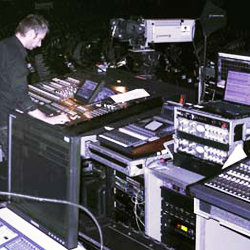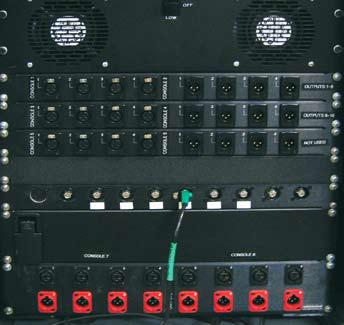
Flexible I/O, Multiple Choices
Several customers expressed an interest in a high-quality all-digital multiple console signal path for festival situations.
Adamo chose the Yamaha DME64 not only because he is known as “Mr. Yamaha digital console,” but also because the product uniquely offers a large and flexible I/O count in a single integrated package.
Other solutions are possible, but they would have to be built from 8 x 8 sub-chassis and integrated. In addition, operating at a 96 kHz sample rate helps win arguments about sound quality.
The DME Festival Matrix is based around the modern mixing concept of four output channels from each console designed to feed the left and right mains, plus the subwoofers (often driven from an independent auxiliary send) as well as a mono front fill send that can be needed to compensate for the lack of stage volume from typical IEM stages.
With the guidance from Yamaha wizard Steve Seable, Adamo programmed the DME64 using DME Designer software to build a 32-input (eight console) by 24-output channels matrix.
Pick A Card
The DME64 has four MY card slots. Two slots employ Yamaha MY8AE96 cards to provide four sets of quad channels of AES digital for 96 kHz consoles, such as a PM5D-RH or a DM2000.
The third slot uses a MY8AE96-S card, which incorporates sample conversion allowing two 48 kHz consoles, such as an Avid Profile or a DiGiCo D5, to feed the DME64 (again, which runs at 96 kHz).
The DME64 is also packaged with an Apogee Big Ben digital word clock to synchronize it with digital consoles and digital loudspeaker processors.
Two of the Big Ben’s outputs are used in a “divide by 2” mode to provide a 48 kHz clock source to the 48 kHz desks and improve their sample rate conversion.
The fourth slot of the DME64 uses an MY8ADDA 8-channel analog I/O card to accept two analog consoles, while also providing eight analog outputs for ancillary feeds such as video, press mult and hearing impaired systems with parametric EQ available.
The first two MY cards provide sixteen 96 kHz outputs, typically to drive the Dolby Lake processors or other loudspeaker system controllers digitally, maintaining a digital path throughout the system. The DME64 also has delays available to any of the outputs, if needed.
A tablet PC is incorporated to control and monitor audio, as the DME64 has minimal front-panel instrumentation.
The 4RU DME64 is housed in a 12RU rack along with the Big Ben and an APC UPS, and there are drawers to hold the console looms and tablet PC, plus a rugged illuminated switch panel connected to the DME64’s GPI EuroBlock connectors to control changeovers between up to eight consoles.
Rear panels provide XLRs for digital and audio I/O as well as BNCs for shipping word clock to other digital equipment.

